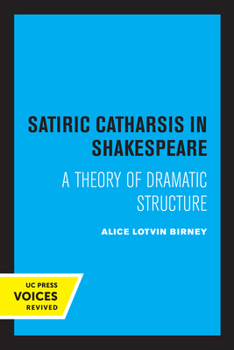Satiric Catharsis in Shakespeare: A Theory of Dramatic Structure
Select Format
Select Condition 
Book Overview
Alice Lotvin Birney reopens the most intractable question in aesthetics--catharsis--and relocates it in the charged arena of satire. Arguing that Aristotle's purgation can illuminate drama driven by invective as surely as it explains tragedy, Satiric Catharsis in Shakespeare proposes a twofold model: the satirist's own psychic "release" and the audience's socially consequential purgation. Through closely argued, exegetical readings, Birney tracks how Shakespeare manipulates hatred, censure, and reformist energy--emotions native to satire--either to purge them harmlessly or to leave them provocatively unresolved. Four early histories culminating in *Richard III* reveal the curse as primitive satire; the Henriad tests whether Falstaff's corrosive wit cleanses or corrupts; *As You Like It* models a comic society that expels its railer to restore equilibrium; *Troilus and Cressida* refuses release, letting Thersites' disease-like scorn infect the whole play; *Timon of Athens* completes a cathartic circle in which the misanthrope dies as tragic scapegoat. Birney's governing insight is structural and political. Where Plato feared art that agitates the polis, Shakespeare sometimes prevents satiric catharsis so that satire "works," and sometimes effects catharsis to stabilize the fictional commonwealth--and, by implication, its audience. Bridging classical theory and Renaissance stagecraft, the book clarifies how mimetic "cures" (scapegoat expulsions) differ from disturbances intended to spur change, and how Shakespeare calibrates that choice through voice, plot stasis or resolution, and the placement of the satirist within the action. A substantial critical apparatus surveys scholarship through 1968, while the conclusion extends the model from Aristophanes to Brecht. Written with clarity and argumentative rigor, this study offers Shakespeareans, theorists of satire, and historians of performance a durable framework for understanding how dramatic structures manage the volatile energies of social critique. This title is part of UC Press's Voices Revived program, which commemorates University of California Press's mission to seek out and cultivate the brightest minds and give them voice, reach, and impact. Drawing on a backlist dating to 1893, Voices Revived makes high-quality, peer-reviewed scholarship accessible once again using print-on-demand technology. This title was originally published in 1973.
Format:Paperback
Language:English
ISBN:0520325540
ISBN13:9780520325548
Release Date:July 2022
Publisher:University of California Press
Length:170 Pages
Weight:0.48 lbs.
Dimensions:0.4" x 5.5" x 8.3"
Customer Reviews
0 rating





